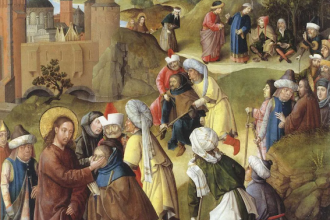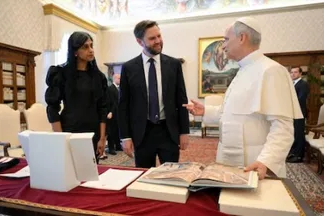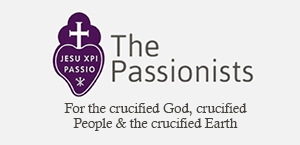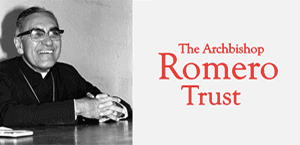Gospel in Art: Dedication of the Basilicas of Saints Peter and Paul, Apostles
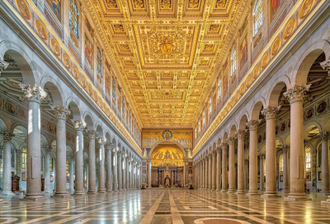
Interior of St Paul Outside the Walls, Rome © Alamy
Source: Christian Art
Gospel of 18 November 2025
Luke 19:1-10
At that time: Jesus entered Jericho and was passing through. And behold, there was a man named Zacchaeus. He was a chief tax collector and was rich. And he was seeking to see who Jesus was, but on account of the crowd he could not, because he was small in stature. So he ran on ahead and climbed up into a sycamore tree to see him, for he was about to pass that way. And when Jesus came to the place, he looked up and said to him, 'Zacchaeus, hurry and come down, for I must stay at your house today.' So he hurried and came down and received him joyfully. And when they saw it, they all grumbled, 'He has gone in to be the guest of a man who is a sinner.' And Zacchaeus stood and said to the Lord, 'Behold, Lord, half of my goods I give to the poor. And if I have defrauded anyone of anything, I restore it fourfold.' And Jesus said to him, 'Today salvation has come to this house, since he also is a son of Abraham. For the Son of Man came to seek and to save the lost.'
Reflection on the basilica
Today's feast commemorates the dedication of two of the most significant basilicas in Rome, honouring Saints Peter and Paul, the foundational figures of the Church and its missionary work. The origins of the basilicas of St. Peter and St. Paul date back to the 4th century, during the reign of the Roman Emperor Constantine the Great. Constantine was the first Roman emperor to convert to Christianity and played a pivotal role in its spread. He ordered the construction of major Christian sites in Rome, including these two basilicas, as public markers of the faith. St. Peter's Basilica was built over the tomb of St. Peter. St. Paul's Basilica, also known as St. Paul Outside the Walls, was constructed outside the original city walls of Rome on the site where St. Paul was buried.
The original St. Peter's Basilica was completed around 360 A.D. but eventually deteriorated. In the 16th century, Pope Julius II commissioned a new basilica to be built on the same site. Pope Julius II enlisted some of the era's most talented architects and artists to design and build the basilica. Donato Bramante was the first to provide a design, proposing a Greek cross layout with a grand central dome. Following his death, other artists, including Raphael, Michelangelo, and Gian Lorenzo Bernini, contributed to the project over the decades. Michelangelo, in particular, played a pivotal role as he took over the design in 1547 and created the now-famous dome, which remains one of the most recognizable architectural features of the basilica. St. Peter's Basilica was ultimately completed in 1626.
St. Paul Outside the Walls also underwent a major reconstruction after a devastating fire in 1823, which nearly destroyed all of the original basilica which had stood there also since the 4th century. Following the fire, Pope Leo XII and successive popes oversaw a meticulous rebuilding process. The basilica was rebuilt to closely resemble the original, with its grand nave, towering arches, and integrating the early Christian mosaics that survived the fire. The new structure was completed in 1840. The Benedictine monks' presence at St. Paul Outside the Walls dates back to the 9th century. Their centuries-old presence contributes to the contemplative atmosphere of St. Paul Outside the Walls. When I was training for the priesthood at the Beda College, just across from St Paul's, I would often slip into the basilica to pray. Its calm, monastic space seems to draw any visitor naturally into silence.
Our photo shows the interior of St Paul Outside the Walls. You will notice straight above the arched supports, a row of mosaic medallions including portraits. These medallions depict all the popes from St Peter to the current Pope. It commemorates the continuity of the papacy thought the last 2,000 years. From St. Peter to Pope Leo XIV, there have been 267 popes in the history of the Catholic Church.
LINKS
Gospel in Art: https://christian.art/
Today's Reflection: https://christian.art/daily-gospel-reading/luke-19-1-10-2025/
and
Video: The Art of Remembrance - From The Monuments Men to The Last Post: www.indcatholicnews.com/news/53644



